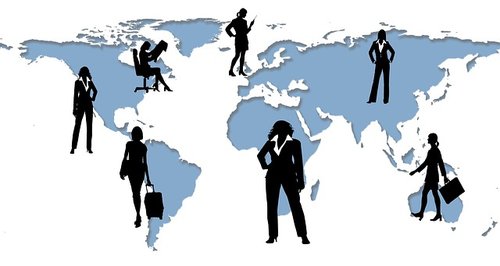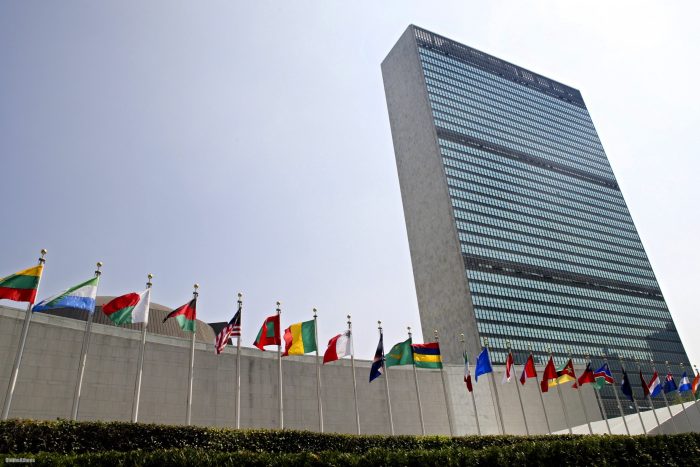
So perhaps there is no higher goal for ambitious translators and interpreters then to work for the United Nations. The UN’s express stated purposes are such lofty humanitarian goals as ending global conflict, alleviating poverty, combating climate change and defending human rights worldwide.
The UN exists only because of the work of translators and interpreters. Translators and interpreters are the very foundation of the idea of nations coming together, and they make the work of the UN possible.

The UN Is The Highest Goal For Translators And Interpreters
Translators and interpreters for the UN travel all over the world, meet a lot of interesting people, and sometimes have access to the kind of global political intelligence that you’re not allowed to discuss with your friends and family.
It’s a high pressure job. Simultaneous interpreters have to think quickly, translating idea-by-idea when literal translation isn’t viable. Translators have to deliver immaculate accuracy, as people’s lives hang on the words they translate.
For these reasons, the UN has the most rigorous standards for their translators and interpreters. To work at such an elite level requires much more than just language skills. For example, you may have a decent grasp of French, but are you confident interpreting the technical language of arms control or global market fluctuations from a flowery African dialect of French into International English?
The six official languages of the UN are:
- Arabic
- Chinese
- English
- French
- Russian
- Spanish
If a presenter to the UN, like a world leader, doesn’t speak one of these languages, they must bring their own interpreter, as Omar Qadaffi did in his famous 2009 speech. He delivered the rambling, hour and a half rant in a Libyan dialect instead of Libya’s official language, Arabic.
That meant the speech required multiple interpreters; Qadaffi’s personal interpreter translated into a UN language, and UN interpreters turned that around into other UN languages. This is the maximum number of interpretations allowed, lest room for error increase.
What Is Required Of UN Translators And Interpreters?
There are thousands, possibly even hundreds of thousands, of professional translators and interpreters working in the world today. It’s nearly impossible to get an accurate count, because there are so many freelancers with informal or periodic working arrangements. But whatever the number, only the very best of these can become UN translators and interpreters.
The UN’s translators and interpreters must have not only excellent comprehension, but the ability to handle high pressure situations with calm and grace. A flawless command of one of the official UN languages, as well as fluency in two others, is the primary prerequisite.
If your primary language is:
English
You must pass the UN’s examination requirements for French, as well as one other UN language.
Arabic, French, Russian or Spanish
You must pass the UN’s examination requirements for any two UN languages in addition to your primary language.
Chinese
You must pass the UN’s examination requirements for English, and preferably one other UN language as well.
The UN organizes exams periodically, in keeping with their need for new translators and interpreters. They also arrange language competitive exams (LCEs) to recruit language professionals. In addition to translators and interpreters, language professionals can include editors, verbatim reporters, copy preparers, proofreaders, production editors and more.
Acceptance to a position at the UN commences with six months to two years of training at the UN Headquarters in New York City. Upon completion of this training, it’s possible to transfer to one of the translation stations at one of the UN offices in Geneva, Vienna, or Nairobi.
They also sometimes need translators and interpreters working on multilateral communications in cities like Addis Ababa, Bangkok, Beirut and Santiago. In some instances, you can serve at one of the regional UN commissions elsewhere in Asia, Africa or Latin America.

The Demands Of Simultaneous Interpreting
While the UN offers work in many kinds for translators and interpreters, the most famous is its well known simultaneous interpreters. These are the terps who are in the ears of the world leaders and the broadcasting networks in real time, as speakers delivering their messages.
The UN’s simultaneous interpreters work in pairs. They trade off every half hour. This gives them some relief from the pressure and ensures that they can maintain their focus.
Speaking and listening at the same time takes a lot of practice. It engages a region of the brain known as the Broca’s area, which is responsible for language production, while simultaneously engaging the caudate nucleus and the putamen, cerebral structures responsible for language learning.
In her lecture A Formula for Success in Simultaneous Interpreting, Professor Chikako Tsuruta says that an interpreter has to remain “cool, calm, collected and connected,” even under the glare of stage lights or network TV cameras.
She says that the 2 pillars of successful interpreting are:
- Public speaking skills
- Background knowledge of current events
Furthermore, Tsuruta conducted a survey on successful simultaneous interpreting. The results highlight these qualities as essential to good delivery and communication skills for an interpreter:
- Fluency of delivery
- Logical cohesion
- Correct terminology
- Pleasant voice
- Synchronicity
- Sense consistency
- Live intonation
- Appropriate style
- Completeness
- A native accent
- Correct grammar
Advice From A UN Interpreter
In her article for the Guardian, How I became a UN interpreter, Helen Reynolds-Brown discusses the joys and perils of her job jetsetting for the UN.
It took her six months of testing, interviewing and vetting before she was accepted to a position. The job was freelance, but after a year of steady work she felt stable.
Reynolds-Brown’s key piece of advice is that university level language study was essential for giving her a springboard into mastery (of French and Russian in her case).
She recommends this as a starting point for any aspiring UN translators and interpreters. However, she notes that even A-level performance in university language classes didn’t bring her to fluency. That only started to happen when she lived in St. Petersburg. And even then she says she could only “scratch the surface” of understanding Russian culture.
She says that the job is complicated with all of its travel demands, especially because she has a spouse and a baby. It’s intense and high pressure. But she says she makes it work, and enjoys the thrill. Furthermore it pays well, and she only has to work about ten days a month.
Recognizing The Work Of Translators And Interpreters
The hard work and unique contributions of UN translators and interpreters doesn’t go unnoticed.
Earlier this year, the UN declared September 30th to be International Translation Day. It’s a moment to recognize the unique and important function that translators and interpreters play at the UN, and in the world in general. By extension, it’s also a way of honoring how translators and interpreters protect linguistic diversity, and bring us closer to global peace and unity.
“This resolution is about the underappreciated role of language in the life of our human society,” said Andrei Dapkiunas, Permanent Representative of Belarus to the United Nations, in a presentation on that day. “We feel that this deserves further discussion, perhaps legal protection of those translators working in conflict zones and in situations of higher risks.”
While the UN’s acknowledgement makes it more official, the world has been celebrating translators and interpreters on September 30th for over 60 years.
The International Federation of Translators (FIT) initiated the holiday in 1953 to correspond with the feast of St. Jerome, the patron saint of translators and interpreters. St. Jerome is famed for translating the Bible directly from its original languages into Latin, instead of transcribing it from more recent translations, as was the custom.
The annual day of recognition gives us pause to appreciate and acknowledge the lengths that translators and interpreters go to so that international communication is possible.

More Information On Joining The UN Translators And Interpreters
If you’re interested in joining the ranks of translators and interpreters working for the UN, you can see the specific outlines of their application requirements on the UN’s careers page.
You can expect to do a lot of intensive studying, the pressures of which will only be matched by the exciting job itself. Translators and interpreters for the UN enjoy a solid career with prestige among the language industry and an active, international lifestyle. They also get to go to sleep at night knowing that they’re directly impacting the world forum with the work that they’re doing.
If your calling lies elsewhere, remember the role that translators and interpreters play in global peace, disarmament, ending poverty, advancing human rights, and promoting international understanding worldwide.
The aims are lofty, but the importance of translators and interpreters at this level is impossible to overstate. The world needs you!
https://www.daytranslations.com/